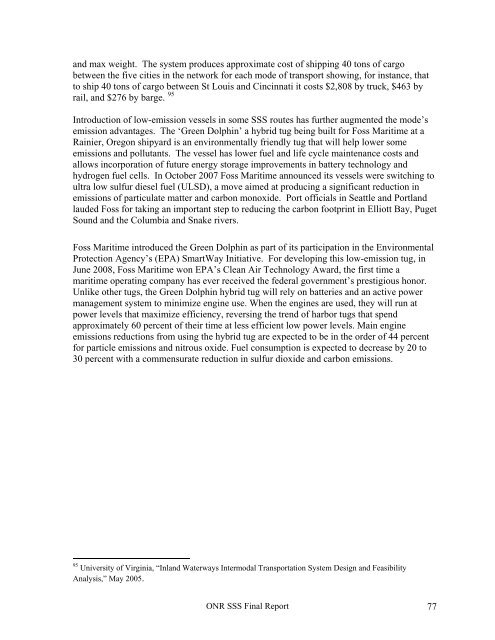Office of Naval Research - National Transportation Library
Office of Naval Research - National Transportation Library
Office of Naval Research - National Transportation Library
You also want an ePaper? Increase the reach of your titles
YUMPU automatically turns print PDFs into web optimized ePapers that Google loves.
and max weight. The system produces approximate cost <strong>of</strong> shipping 40 tons <strong>of</strong> cargobetween the five cities in the network for each mode <strong>of</strong> transport showing, for instance, thatto ship 40 tons <strong>of</strong> cargo between St Louis and Cincinnati it costs $2,808 by truck, $463 byrail, and $276 by barge. 95Introduction <strong>of</strong> low-emission vessels in some SSS routes has further augmented the mode’semission advantages. The ‘Green Dolphin’ a hybrid tug being built for Foss Maritime at aRainier, Oregon shipyard is an environmentally friendly tug that will help lower someemissions and pollutants. The vessel has lower fuel and life cycle maintenance costs andallows incorporation <strong>of</strong> future energy storage improvements in battery technology andhydrogen fuel cells. In October 2007 Foss Maritime announced its vessels were switching toultra low sulfur diesel fuel (ULSD), a move aimed at producing a significant reduction inemissions <strong>of</strong> particulate matter and carbon monoxide. Port <strong>of</strong>ficials in Seattle and Portlandlauded Foss for taking an important step to reducing the carbon footprint in Elliott Bay, PugetSound and the Columbia and Snake rivers.Foss Maritime introduced the Green Dolphin as part <strong>of</strong> its participation in the EnvironmentalProtection Agency’s (EPA) SmartWay Initiative. For developing this low-emission tug, inJune 2008, Foss Maritime won EPA’s Clean Air Technology Award, the first time amaritime operating company has ever received the federal government’s prestigious honor.Unlike other tugs, the Green Dolphin hybrid tug will rely on batteries and an active powermanagement system to minimize engine use. When the engines are used, they will run atpower levels that maximize efficiency, reversing the trend <strong>of</strong> harbor tugs that spendapproximately 60 percent <strong>of</strong> their time at less efficient low power levels. Main engineemissions reductions from using the hybrid tug are expected to be in the order <strong>of</strong> 44 percentfor particle emissions and nitrous oxide. Fuel consumption is expected to decrease by 20 to30 percent with a commensurate reduction in sulfur dioxide and carbon emissions.95 University <strong>of</strong> Virginia, “Inland Waterways Intermodal <strong>Transportation</strong> System Design and FeasibilityAnalysis,” May 2005.ONR SSS Final Report 77
















